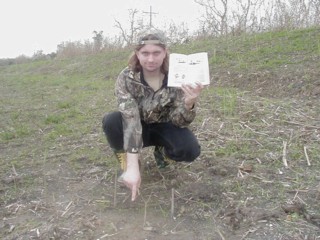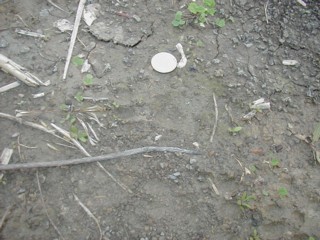| |
Archive
> Features
|
|
| |
|
Are US 'Black Panthers' Actually Jaguarundi?
by
Chester Moore, Jr.
|
"Black
panthers" exist in the United States.
This isn't a theory, hypothesis or hallucination, but a verifiable,
undeniable fact.
No, science hasn't discovered a new cat species or a population of
melanistic (black) cougars to explain alleged "black panther"
sightings. They haven't even captured a black leopard that escaped from
one of those circus train wrecks skeptics of cryptozoology so often
speak of.
Yes, there are "black panthers" in the United States but believing in
their existence doesn't require a leap of faith. It just calls for a
new look at a known species: the jaguarundi.
The jaguarundi (Felis yagouaroundi) is known to range from South
America to Texas, New Mexico and Arizona. And although not widely known
by the public, jaguarundis are prime candidates for spawning "black
panther" reports.
They are a medium-sized cat with a mean body size of 102 centimeters
for females and 114 for males according to Mexican researcher Arturo
Caso. Other sources list them as ranging from 100 to 120 centimeters
with the tail making up the greatest part of the length.
Most specimens are about 20 centimeters tall and sport a dark gray
color while others are chocolate brown or blonde.
A large jaguarundi crossing a road in front of a motorist or appearing
before an unsuspecting hunter could easily be labeled a "black
panther". Since very few people are aware of jaguarundis, it's highly
unlikely they would report seeing one. The term "black panther" is
quick and easy to report to others.
Everyone can relate to a "black panther".
North of the border
Jaguarundis are known to range from South America to the Mexican
borders of Texas, Arizona and New Mexico. The key word here is "known".
That means scientists have observed or captured the species within
those areas, however they are reported to range much farther north in
the Lone Star State and perhaps elsewhere.
Texas Parks and Wildlife Department (TPWD) officials solicited
information from the public and received numerous reports of the
species in the 1960s, including several sightings from central and east
Texas. Additional sightings were reported from as far away as Florida,
Oklahoma, and Colorado
In a study conducted in 1984, TPWD biologists noted a string of
unconfirmed jaguarundi sightings in Brazoria County, which corners the
hugely populated areas of both Houston and Galveston.
Brazoria County is more than 200 miles north of the counties of Cameron
and Willacy, which the U.S. Fish and Wildlife Service (Service) has
designated as being the only confirmed areas of Texas that houses
jaguarundis.
This is even more interesting when considering what TPWD biologist
Terry Turney has to day.
Turney is now an endangered species biologist in Kendall County but
spent the early part of his career in Port Arthur, Texas managing the
J.D. Murphree Wildlife Management Area (WMA). On this 30,000-acre tract
of mixed coastal prairie and marsh according to Turney is a population
of jaguarundis.
"While I worked the Murphree Area one of the workers had seen three of
them and the ranchers around the area as well as other members of the
Murphree crew saw them fairly frequently. It was "those little gray
cats" to them," Turney said.
"I had two of them in my neighborhood near Houston in the late 70s and
the dogs would tree them every couple of weeks. They're about the most
secretive critters around," he added.
The J.D. Murphree WMA is more than 300 miles north of the Service's
estimated range. How is it that state workers are seeing these cats in
Port Arthur while the official word is they're only in the southern
extremities of Texas?
In my opinion this is a great oversight by federal biologists who
wrongly believe this cat to only inhabit a specific type of habitat.
Jaguarundis are listed as an endangered species by the Service and full
under federal jurisdiction. And for the most part what the Feds say
goes with endangered species.
A study conducted by Arizona and federal scientists states that
jaguarundi habitat, especially in South Texas, includes dense, thorny
thickets of mesquite and stunted acacias known as chaparral. It also
state less than one percent of this type of habitat is left along the
US-Mexican border.
That's true but jaguarundis are known to live in a variety of habitats,
including rainforests, prairie, deciduous forests and marshland. It
could very well be that very few jaguarundis live in that zone because
of a lack of habitat. Most of that area has been converted to farmland.
The game and habitat-rich areas along the Texas coast along with the
Pineywoods and Hill Country region however is housing a population of
jaguarundis that have slipped under the radar screen of federal
officials.
How far do they range?
If there's any validity to the 1960s TPWD report, sightings have been
recorded in several states bordering Texas. Since TPWD biologists say
the cats are present in Port Arthur, which rests on the Texas-Louisiana
border then it's likely the cats also inhabit that state. It's also
possible they could range into Oklahoma and Arkansas. Gauging how far
they might range throughout New Mexico and Arizona is more difficult
because there have been few studies conducted there. Their ability to
survive in solid desert is also questionable.
Florida has a resident population of jaguarundis that were imported
into that state in the 1940s. Since the cats are so secretive it's
difficult to gauge their population status, but it is generally
believed to be healthy.
This begs the question of how far those transplanted cats have spread?
Are they now in Georgia and Alabama, two states that have frequent
"black panther" sightings?
More research needs to go into this matter.
Personal research
My interest in the jaguarundi connection to "black panther" sightings
comes from a sighting that took place in the summer of 2001 near Port
Arthur, Texas. At around 9 a.m. while driving in a rural area I
witnessed a long, slender, gray-colored animal emerging from the brush
on the side of the road at a distance of about 75 yards. When I
approached to within 30 yards the animal slowly walked in the middle of
the road and crossed into a brushy area on the other side. Having
worked with more than 11 species of wild cats at the Exotic Cat &
Wildlife Refuge in Kirbyville, Texas and spent time observing the cats
at the Texas Zoo in Victoria I immediately identified the cat as a
jaguarundi.
I was shocked at what I had seen, but remembered a local minister
telling me about a biologist at the J.D. Murphree WMA, (which was less
than a miles from where this sighting took place) seeing jaguarundis.
That biologist was Terry Turney.
I returned to the area several times and have been able to cast a
number of tracks. Jaguarundis have a footpad that is slightly different
from the bobcat, which also inhabits the area, and after several
comparisons to bobcat casts I have made it's obvious that at least some
of the tracks are of jaguarundi origin.
Several of the tracks were made in a damp area and have absolutely
perfect definition so an adequate review of field guide diagrams and
photos of tracks taken in Mexican was made. The footpad of some of the
others is too vague for me to give a positive identification.
The best track by the way was found less than 150 yards from where I
saw the cat in 2001.
At the time of this writing a Buckshot 35 motion-sensing camera has
been put on a trail where the most recent tracks were found. I'm hoping
a jaguarundi will step in front of it and give photographic evidence of
this fascinating feline ranging more than 300 miles from where federal
managers say it lives.
Chester
Moore points to a jaguarundi track near the area where he
saw one. That's a Petersen's Field Guide in his hand. Jaguarundis have
a
slightly different foot pad than bobcats and domestic cats and Moore is
meticulous about positively identifying animal sign.
|

|
In conclusion
Is the jaguarundi responsible for all "black panther" reports in the
United States? That's not likely.
Are they the source of many sightings in the South and Southwest? There
is no doubt in my mind.
Besides the obvious physical characteristics that match them to "black
panther" sightings there are some habits of the species that also lend
credence to this theory.
Jaguarundis are diurnal meaning they hunt mostly in daylight hours and
this goes along with many reportings I have collected of "black
panthers."
Several eyewitnesses insisted the cat they saw wasn't a cougar or
bobcat because they saw it in the middle of the day. They said they got
a good look at a dark, long-tailed cat. Bobcats and cougars are chiefly
nocturnal while the jaguarundi is a daylight dweller.
Looking back it's funny that for years I lamented at never seeing one
of the "black panthers" I so frequently gathered reports of. It seemed
as if I was living in a Mecca for mystery cat sightings, but a glimpse
of the cat itself always eluded me.
Then I saw a jaguarundi cross the road in front of me. It took a little
researching and thinking time for it to sink in, but I finally figured
out I had seen a black panther.
It just came in a slightly different package than I was expecting.
Here's
a jaguarundi track with a quarter for comparison.
|

|
Chester Moore's web site dealing with
cryptozoology can be found at www.cryptokeeper.com. You can e-mail him
at ibill@cryptokeeper.com.
References
Caso, Arturo. Personal interview. 5, Feb. 2002.
Mabie, D.W. 1984. Feline Status Study. Ann. Perf. Report. Fed. Aid
Proj. No. W-103-R-14, Job 12, Texas Parks and Wildl. Dept., Austin. 3pp.
U.S. Fish and Wildlife Service. 1985. Technical Draft: Recovery Plan
for the Listed Cats of Arizona and Texas. U.S. Fish and Wildl. Serv.,
Albuquerque, NM. 65 pp
Turney, Terry. Personal interview. 23, Jan. 2002
Tewes, M.E. and D.D. Everett. 1985. Status and distribution of the
Endangered ocelot and jaguarundi in Texas. Internat. Wildlife
Symposium, Kingsville, TX.
Hock, R.J. 1955. Southwestern exotic felids. Amer. Midland Nat.
53:324-328.
Davis, W.B. 1974. The mammals of Texas. Texas Parks and Wildlife. Bull.
No. 41. 252 pp.
©2002 Chester Moore, Jr. |
|
|
|



